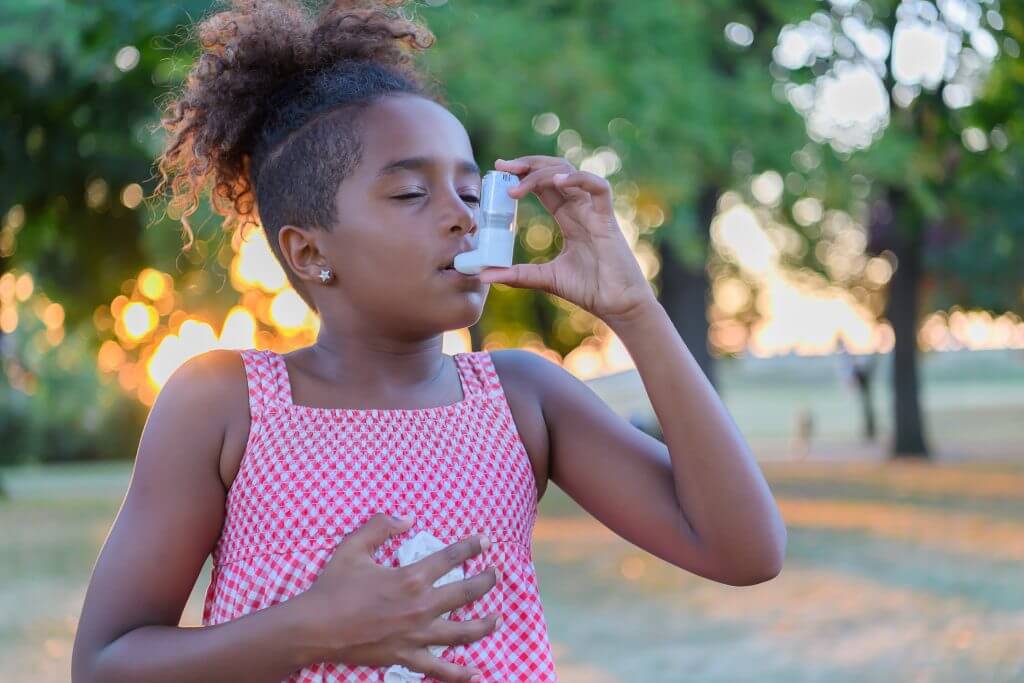Your Guide to Getting Your Child’s Asthma Under Control
Being prepared can make managing asthma a lot less stressful. These tips can help you prevent your child from having an asthma attack — and let you know exactly when to call for help.

As a parent, you naturally want to protect your child from the symptoms and stress of illness as much as possible. So seeing them deal with a life-disrupting condition like asthma can be tough. But while asthma isn’t curable, it can be very controllable.
Learning what triggers your child’s asthma, how to avoid or lessen those triggers, and what to do in an emergency can take a lot of the guesswork and anxiety out of managing the condition. The first step to helping control your child’s asthma begins with a plan. Here’s how to make one and put it into action.
What is an Asthma Action Plan?
An Asthma Action Plan is an individualized guide to tracking, controlling, and reacting to your child’s asthma every day. It’s one of the most important tools in your asthma-control toolbox, and you should create it with your child’s doctor. They can give you a template, or you can download one here to get started.
Most plans are split into 3 zones:
- Green zone: Doing well.
- Yellow zone: Reason for caution.
- Red zone: Danger.
Each zone lists the symptoms (or lack of them) your child might feel, how those symptoms should be treated, what to do if the symptoms get worse, and when to call your doctor or get emergency help. When you fill in your action plan, be sure to include:
- Triggers that make your child’s asthma worse.
- The specific names and doses of medicines your child takes and in which situations they should take them. (Consider keeping photos of them on your cell phone, too.)
- Emergency contact information.
- Insurance card copies. (Keeping a photo on your cell phone can also come in handy.)
You and your child should look at the Asthma Action Plan daily, says Marilyn Li, MD. Dr. Li is an allergist and associate professor of pediatrics at the Keck School of Medicine at the University of Southern California. You can use the plan for daily reminders and to watch for common asthma symptoms like shortness of breath, coughing, chest tightness, or wheezing.
Make multiple copies of your plan. Keep one with your child’s asthma medication and another in a visible spot like on your refrigerator. Some people have their plan laminated — handy for making notes on it with a dry-erase marker — or they keep a photo of it in their cell phone. Your child’s school should also have a copy. Action plans should be updated at least once a year or with any medication changes, Dr. Li says.
Interested in receiving additional tips and insights on managing your conditions, healthy living, and getting the most out of your benefits? Click here to sign up for our free newsletter.
How do you monitor and track your child’s asthma symptoms?
Tracking your child’s asthma symptoms daily is a great way to help identify problems early, when they’re easier to address. Use your action plan as a guide for what symptoms to look for, and then write down in a journal which ones your child is experiencing.
You might also want to use a peak-flow meter. This small handheld device measures how well your child can blow air out of their lungs — a sign of how well their asthma is controlled. Peak-flow numbers are a more objective way to tell when your child’s asthma symptoms may be getting worse. Your doctor may prescribe a peak-flow meter, or you can buy one over-the-counter at most pharmacies.
Typically, you’ll want your child to use the meter at least once a day, at the same time every day. You should take 3 readings and record the highest of them in your child’s asthma journal. When you’ve done this for about 3 weeks during a period when your child’s asthma is well under control — as in, they feel good with no asthma symptoms — circle the highest number. That number is what’s known as their “personal best.”
Record your child’s personal best on their action plan. Then calculate your child’s peak-flow range for each of the 3 zones:
- Green zone: A normal peak-flow rating is 80% to 100% of their personal best.
- Yellow zone: A peak flow between 50% to 80% of their personal best falls in the caution zone.
- Red zone: A peak flow that’s less than 50% of their personal best falls in the danger zone.
Write these numbers on your action plan. Your child’s doctor can help you figure out the peak-flow ranges. So can a digital health management tool like Wellframe. These smartphone apps are offered by many health plans and employers. They can connect you quickly with your child’s care team to help answer all your asthma-related questions.
“For those with severe asthma flare-ups that happen quickly, peak flows are useful at detecting that downward spiral earlier,” Dr. Li says. “But they do need a person to be really dedicated to using it regularly.”
Contact your health plan to see if you’re eligible for Wellframe.
Which asthma medications should you give your child?
There are 2 main types of asthma medication: long-term control medication and quick-relief (rescue) medication. Long-term medications are meant to be taken daily on a long-term basis to control and prevent your child’s asthma symptoms. Quick-relief medications, such as rescue inhalers, are meant to provide immediate relief of asthma symptoms.
If your child regularly experiences asthma symptoms, or if their asthma symptoms are severe, they will probably need to use long-term control medications. It’s very important to take these medications every day, even when your child is feeling fine (think green zone), Dr. Li says. That’s because long-term control medications actually treat the underlying issues — like inflammation — that can lead to asthma symptoms. That’s different from quick-relief medications, which just treat the symptoms themselves.
What are common asthma triggers, and how can you control them?
Most asthma symptoms — although not all — have a trigger. Triggers can include environmental factors, illnesses, and more. Big ones on the list include:
- Colds, the flu, or other respiratory infections.
- Exercise.
- Smoke, cleaning products, and other sources of air pollution.
- Allergens like pollen, mold, dust mites, and pet dander.
- Stormy weather (which can put more pollen in the air).
- Food allergies.
- Strong emotions like stress and anger.
- Gastroesophageal reflux. This condition causes the contents of the stomach to flow backward into the esophagus. Some kids inhale the contents into their lungs, which can damage the airways and worsen asthma.
- Inflammation. When the airways are inflamed, it can make them more sensitive to certain triggers that can cause an asthma attack. That’s why your child might have to take an anti-inflammatory long-term control medication.
Tracking your child’s asthma symptoms, along with allergy testing, can hopefully give you an idea of what triggers their symptoms. The more you can limit their exposure to these triggers, the better. These steps can help:
- Make sure your child takes the long-term control medication as prescribed.
- Keep heartburn or acid reflux under control with medication.
- Make sure your child gets a yearly flu shot.
- Keep track of pollen counts and try to stay indoors on days when pollen counts are high.
- Watch local weather forecasts for high air pollution days and avoid playing outdoors when air quality is low.
- Regularly dust your home with a damp cloth to remove pet and dust mite allergens.
- Help your child learn to regulate stress, anger, and anxiety, using techniques such as deep-breathing exercises.
- Use scent-free cleaning products.
When should you get help for an asthma attack?
You should never hesitate to call your child’s doctor or get urgent or emergency help if you’re worried about your child’s asthma, Dr. Li says. But it can also be helpful to know some of the common warning signs that it’s time to call your child’s doctor or 911.
Call your child’s doctor if:
- They are very short of breath.
- Their symptoms aren’t improving after using quick-relief medication.
- Their yellow zone symptoms (coughing, wheezing, chest tightness) are the same or getting worse after 24 hours.
If your child is having trouble walking or talking and their lips or fingernails have turned pale or blue, you should go to the hospital or call 911 for an ambulance right away. “Generally, whenever your child’s symptoms are in the yellow or red zone, always be ready to leave for the hospital or call 911,” Dr. Li says. Of course, it’s scary to think about having to take your child to the hospital, but having an Asthma Action Plan will ensure the best possible outcome — and we can all take comfort in that.
